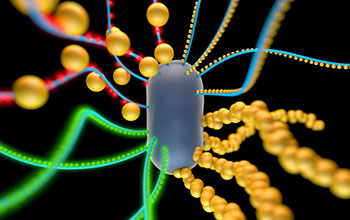Multimedia Gallery
Engineers design 'living materials'
An artist's depiction of a bacterial cell engineered to produce amyloid nanofibers that incorporate particles such as quantum dots (seen here as red and green spheres) or gold nanoparticles.
More about this image
Inspired by natural materials like bone -- a matrix of minerals and other substances, including living cells -- engineers at the Massachusetts Institute of Technology (MIT) have coaxed bacterial cells to produce biofilms that can incorporate nonliving materials, such as gold nanoparticles and quantum dots.
These "living materials" combine the advantages of live cells, which respond to their environment; produce complex biological molecules; and span multiple length scales, with the benefits of nonliving materials, which add functions such as conducting electricity or emitting light.
Timothy Lu, an assistant professor of electrical engineering and biological engineering and the senior author of a paper describing the living functional materials, says the new materials represent a simple demonstration of the power of this approach, which could one day be used to design more complex devices such as solar cells, self-healing materials or diagnostic sensors.
The research was supported in part by a grant from the National Science Foundation.
To learn more about this research, see the MIT news story Engineers design 'living materials'. (Date image taken: unknown; date originally posted to NSF Multimedia Gallery: Nov. 09, 2015)
Credit: Yan Liang (L2Molecule.com)
See other images like this on your iPhone or iPad download NSF Science Zone on the Apple App Store.
Images and other media in the National Science Foundation Multimedia Gallery are available for use in print and electronic material by NSF employees, members of the media, university staff, teachers and the general public. All media in the gallery are intended for personal, educational and nonprofit/non-commercial use only.
Images credited to the National Science Foundation, a federal agency, are in the public domain. The images were created by employees of the United States Government as part of their official duties or prepared by contractors as "works for hire" for NSF. You may freely use NSF-credited images and, at your discretion, credit NSF with a "Courtesy: National Science Foundation" notation.
Additional information about general usage can be found in Conditions.
Also Available:
Download the high-resolution JPG version of the image. (2.9 MB)
Use your mouse to right-click (Mac users may need to Ctrl-click) the link above and choose the option that will save the file or target to your computer.

